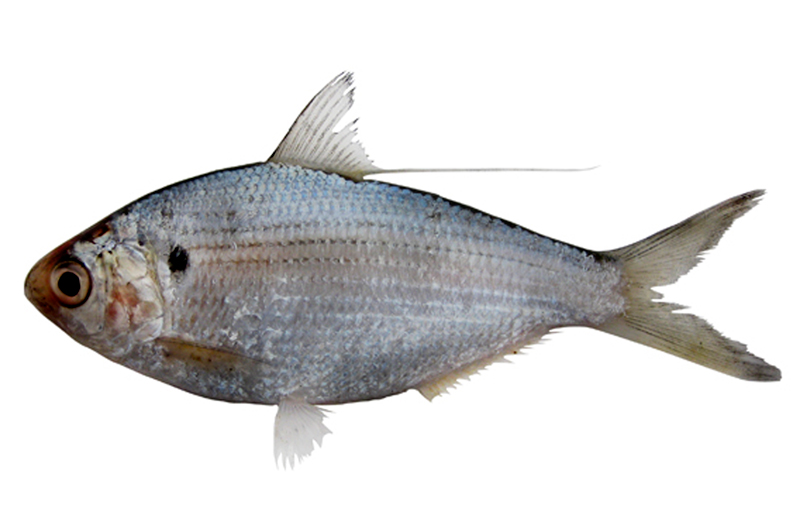Hairback Herring, Nematalosa come (Richardson 1846)
Other Names: Hair-back Herring, Perth Herring, Western Pacific Gizzard Shad

Hairback Herring, Nematalosa come. Source: Australian National Fish Collection, CSIRO. License: CC BY Attribution-Noncommercial
Summary:
A silvery herring with a dark spot behind the gill opening, and milky white tips on the pelvic and anal fins.
Cite this page as:
Bray, D.J. 2024, Nematalosa come in Fishes of Australia, accessed 10 Jul 2025, https://fishesofaustralia.net.au/home/species/2060
Hairback Herring, Nematalosa come (Richardson 1846)
More Info
|
Distribution |
Widespread in Australia, from the Swan River, Perth, Western Australia, around the tropical north to Bundaberg, Queensland. Elsewhere the species occurs in the west Pacific: Indonesia and Papua New Guinea, north to the Philippines, the East China Sea to the Ryukyu Islands, Japan. The species is pelagic in coastal and estuarine habitats. |
|
Features |
Dorsal fin 15-19; Anal fin 17-26; Pectoral fin 14-17; Pelvic fin 8; Abdominal scutes 18-20 (prepelvic) + 1 (subpelvic) + 10-13 (postpelvic) = 29-31; Trunk scale rows 16-19, caudal peduncle scale rows usually 7, lateral scales usually 45-49; Vertebrae 13-15 + 29-32 = 43-46. Body relatively deep, compressed, depth 36-45% SL; a distinct median notch on upper jaw (when viewed from the front); supramaxilla single, small; margin of lower jaw strongly flared outward. Opercle smooth, without bony striae; anterior arm of preopercle with a fleshy triangular area dorsally, not covered by third infra-orbital bone. Pectoral axillary process large, approximately one-third length of fin. Hind margin of scales not toothed. |
|
Fisheries |
Fished in parts of its range; used a bait in tuna longline fishery. |
|
Species Citation |
Chatoessus come Richardson 1846, Ichthyology of the voyage of H. M. S. Erebus & Terror 2: 62, pl. 38(7-9). Type locality: Western Australia. |
|
Author |
Bray, D.J. 2024 |
|
Resources |
Hairback Herring, Nematalosa come (Richardson 1846)
References
Allen, G.R. 1997. Marine Fishes of Tropical Australia and South-east Asia. Perth : Western Australian Museum 292 pp. 106 pls.
Allen, G.R. & Swainston, R. 1988. The Marine Fishes of North-Western Australia. A field guide for anglers and divers. Perth, WA : Western Australian Museum vi 201 pp., 70 pls.
Chen, M. & Hsiao, J. 1996. The reproductive biology of the Gizzard Shad, Nematalosa come (Richarson, 1846), in the Kaohsiung River and its harbor area, Southern Taiwan. Zoological Studies 35(4): 261-271. See ref online
Grant, E.M. 2002. Guide to Fishes. Redcliffe : EM Grant Pty Ltd 880 pp.
Imai, H., Kashiwagi, F., Cheng, J. H., Chen, T. I., Tachihara, K., & Yoshino, T. 2009. Genetic and morphological evidence of hybridization between Nematalosa japonica and N. come (Clupeiformes: Clupeidae) off Okinawa Island, Ryukyu Archipelago, Japan. Fisheries Science 75(2): 342-350. See ref online
Larson, H.K. & Williams, R.S. 1997. Darwin Harbour fishes: a survey and annotated checklist. pp. 339-380 in Hanley, H.R., Caswell, G., Megirian, D. & Larson, H.K. (eds). The Marine Flora and Fauna of Darwin Harbour, Northern Territory, Australia. Proceedings of the Sixth International Marine Biology Workshop. Darwin : Museum and Art Gallery of the Northern Territory 466 pp.
Munro, I.S.R. 1961. Handbook of Australian fishes. Nos 1–42. Australian Fisheries Newsletter 15–17, 19, 20: 1-172
Munroe, T.A., Wongratana, T. & Nizinski, M.S. 1999. Family Clupeidae. pp. 1775-1821 in Carpenter, K.E. & Niem, V.H. (eds). The Living Marine Resources of the Western Central Pacific. FAO Species Identification Guide for Fisheries Purposes. Rome : FAO Vol. 3 pp. 1397-2068.
Nelson, G.J. & Rothman, M.N. 1973. The species of gizzard shads (Dorosomatinae) with particular reference to the Indo-Pacific region. Bulletin of the American Museum of Natural History 150(2): 133-206 figs 1-13 See ref online
Richardson, J. 1846. Ichthyology. 53-74 pls 31-41, 43-44 & 53 (part) in Richardson, J. & Gray, J.E. (eds). The Zoology of the Voyage of H.M.S. Erebus and Terror under the Command of Captain Sir James Clark Ross, R.N., F.R.S., during the years 1839–43. London : E.W. Janson Vol. 2 139 pp. See ref online
Roughley, T.C. 1957. Fish and Fisheries of Australia. Sydney : Angus & Robertson 341 pp.
Uehara, M., Imai, H. & Tachihara, K. 2009. Age and growth of two gizzard shads, Nematalosa come and N. japonica, in coastal waters around Okinawa Island, southwestern Japan. Fisheries Science 75(2): 295-301. https://doi.org/10.1007/s12562-008-0042-4
Whitehead, P.J.P. 1985. FAO species catalog. Clupeoid fishes of the world (suborder Clupeoidei). Part 1 — Chirocentridae, Clupeidae and Pristigasteridae. FAO Fisheries Synopsis No. 125 Vol. 7 Pt 1. pp. 1-303
Williams, J.T. & Di Dario, F. 2017. Nematalosa come. The IUCN Red List of Threatened Species 2017: e.T75153687A75153727. https://dx.doi.org/10.2305/IUCN.UK.2017-3.RLTS.T75153687A75153727.en. Accessed on 24 September 2024.



